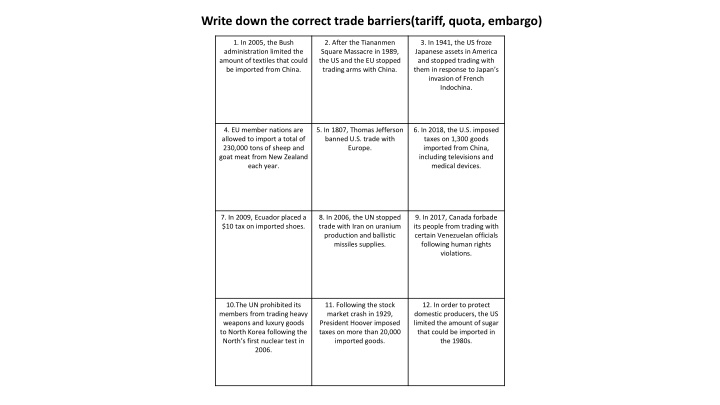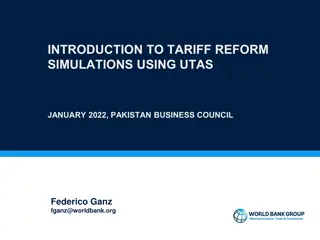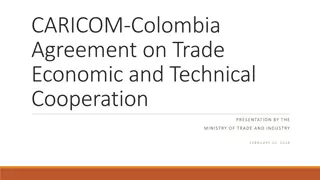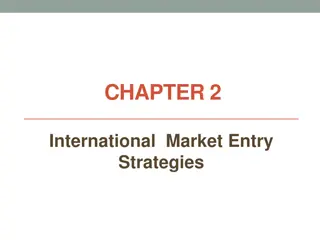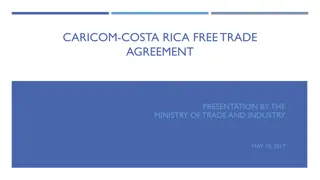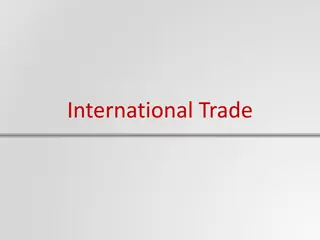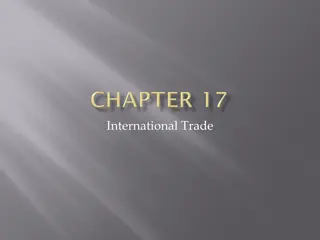Write down the correct trade barriers(tariff, quota, embargo)
Explore various examples of trade barriers including tariffs, quotas, and embargoes imposed by different countries over the years for various reasons such as political events, economic protectionism, and human rights violations.
Download Presentation

Please find below an Image/Link to download the presentation.
The content on the website is provided AS IS for your information and personal use only. It may not be sold, licensed, or shared on other websites without obtaining consent from the author.If you encounter any issues during the download, it is possible that the publisher has removed the file from their server.
You are allowed to download the files provided on this website for personal or commercial use, subject to the condition that they are used lawfully. All files are the property of their respective owners.
The content on the website is provided AS IS for your information and personal use only. It may not be sold, licensed, or shared on other websites without obtaining consent from the author.
E N D
Presentation Transcript
Write down the correct trade barriers(tariff, quota, embargo) 1. In 2005, the Bush administration limited the amount of textiles that could be imported from China. 2. After the Tiananmen Square Massacre in 1989, the US and the EU stopped trading arms with China. 3. In 1941, the US froze Japanese assets in America and stopped trading with them in response to Japan s invasion of French Indochina. 4. EU member nations are allowed to import a total of 230,000 tons of sheep and goat meat from New Zealand each year. 5. In 1807, Thomas Jefferson banned U.S. trade with Europe. 6. In 2018, the U.S. imposed taxes on 1,300 goods imported from China, including televisions and medical devices. 7. In 2009, Ecuador placed a $10 tax on imported shoes. 8. In 2006, the UN stopped trade with Iran on uranium production and ballistic missiles supplies. 9. In 2017, Canada forbade its people from trading with certain Venezuelan officials following human rights violations. 10.The UN prohibited its members from trading heavy weapons and luxury goods to North Korea following the North s first nuclear test in 2006. 11. Following the stock market crash in 1929, President Hoover imposed taxes on more than 20,000 imported goods. 12. In order to protect domestic producers, the US limited the amount of sugar that could be imported in the 1980s.
Factors of Economic Growth Natural Resources, Human Capital, Capital Goods, & Entrepreneurship
Factors of Production There are 4 factors of production that influence economic growth within a country: 1. Natural Resources available 2. Investment in Human Capital 3. Investment in Capital Goods 4. Entrepreneurship The presence or absence of these 4 factors determine the country s Gross Domestic Product (GDP) for the year.
GDP GDP is the total value of all the goods and services produced in that country in one year. It measures how rich or poor a country is. It shows if the country s economy is getting better or worse. Raising the GDP of a country can improve the country s standard of living.
Natural Resources
Natural Resources All of the things found in or on the earth; gifts of nature . All resources are limited. Examples: land, water, sun, plants, time, air, minerals, oil, etc.
Economic Growth Important to countries: without them, countries must import the resources they need (costly) A country is better off if it can use its own resources to supply the needs of its people. If a country has many natural resources, it can trade or sell them to other countries.
Human Capital
Human Capital This is all of the skills, talents, education, and abilities that human workers possess---and the value that they bring to the marketplace. Examples: computer/reading/writing/math skills, talents in music/sports/acting, ability to follow directions, ability to serve as group leader & cooperate with group members A country s Literacy Rate impacts Human Capital (the percent of the population over 15 that can read/write).
Economic Growth Nations that invest in the health, education, & training of their people will have a more valuable workforce that produces more goods & services. People that have training are more likely to contribute to technological advances, which leads to finding better uses of natural resources & producing more goods.
Capital Goods
Capital Goods This is all of the goods that are produced in the country and then used to make other goods & services. Examples: tools, equipment, factories, technology, computers, lumber, machinery, etc. What are some capital goods used in our classroom?
Economic Growth The more capital goods a country has, the more goods & services they are able to produce. If a business is to be successful, it cannot let its equipment break down or have its buildings fall apart. New technology can help a business produce more goods for a cheaper price. Money is NOT a capital good, but rather a medium of exchange!
Entrepreneurship People who provide the money to start and operate a business are called entrepreneurs. These people risk their own money and time because they believe their business ideas will make a profit. They bring together natural, human, and capital resources to produce foods or services to be provided by their businesses. What are some examples of people who are entrepreneurs?
Entrepreneurship Entrepreneurs have 2 characteristics that make them different from the rest of the labor force: 1. innovative (have creative ideas) 2. risk taker (use limited resources in an innovative way in hopes that people will buy the product) It can be several things: Starting your own business Inventing something new Changing the way something was previously done so that it works better
Economic Growth Entrepreneurship creates jobs and lessens unemployment. It encourages people to take risks, and in doing so, they ve created better healthcare, education, & welfare programs. The more entrepreneurs a country has, the higher the country s GDP will be.
Economic Growth Economic growth in a country is measured by the country s Gross Domestic Product (GDP) in one year. o It measures only what has been produced within the country--this doesn t include products that are imported. o It is much better for the economy of a country to produce its own goods and services (this increases the country s GDP). Measuring the GDP each year can: Compare one country s economy to another Check a country s economic progress over time Show if the economy is growing or not
Standard of Living The higher a country s GDP, the better standard of living for the people within the country. In order for a country to have an increasing GDP, it must invest in human capital through education & training, and it must produce goods that have value to be sold within the country or exported.
Summary To encourage economic growth and raise the living standards of its citizens, there must be investment in human capital and capital goods. Economic growth is measured by increases in GDP over time. How large a nation s GDP can be is determined by the availability and quality of its natural, human, and capital resources. To increase economic growth and GDP over time requires investments in both capital (factories, machines) and human capital (education, training, skills of labor force).
Dear Student Write a brief letter to the student who is absent that describes what you have learned about the four factors of economic growth (below). Also include how the factors effect a country s standard of living. The more information that you include, the easier it will be for the absent student to catch up! Natural Resources Human Capital Capital Goods Entrepreneurship
Natural Resources
Human Capital
Capital Goods
